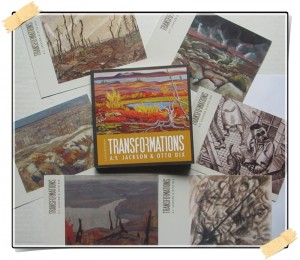A.Y. Jackson spent most of his 91 years acquainting Canadians with their own landscape.
His bold landscapes progress through the calendar of the 20th century, marching in step with Canadian history.
A.Y. Jackson’s artistic trek is linearly laid out in the Canadian War Museum’s current exhibit: A.Y. Jackson and Otto Dix, Art Shaped by War. The exhibit, which closed Sept. 26, marks the 100th centenary of the beginning of the First World War, which A.Y. Jackson fought and painted in.

Photo collage of the catalogue and postcards from Transformations: A.Y. Jackson & Otto Dix exhibit (Photo by Mark Skeffington)
Curator Laura Brandon intrigues the viewer by juxtaposing the lives, artistic careers and artworks of A.Y. Jackson and German artist Otto Dix, each recognized as historically significant to their country’s sense of identity.
Alexander Young Jackson (1882-1974) pre-dated and outlived Otto Dix (1891-1969), but their timelines run remarkably parallel, while their storylines also sometimes cross.
To those familiar with A.Y. Jackson, there are few surprises in the exhibit, though some people may not have been aware of or seen his First World War canvases.
Such paintings as A Copse, Evening (1918) and Vimy Ridge from Souchez Valley (1918) show Europe’s landscape torn asunder by war.
In some cases, the branch-less, twisted trees that remain standing on the battlefield aren’t that different than the trees that dot A.Y. Jackson’s numerous Canadian landscapes.
More arresting, are the works of Otto Dix, an artist not familiar to many Canadians and an artist whose reputation took decades to revive.
Both artists began painting before The Great War, enlisted as soldiers, recorded scenes from the front, and then returned to civilian life, building careers as painters.
A.Y. Jackson went on to help form the Group of Seven, then the Canadian Group of Painters (See full biography). He helped with the Second World War effort, initiating a war poster program, and then led the Sampson-Matthews Ltd. silkscreen project to boost troop morale, before becoming an official war artist for the second time.
Transformations shows that Otto Dix had more trouble than A.Y. Jackson leaving the horrors of the First World War behind when Armistice came in November 1918.
Images from the trenches that haunted Otto Dix culminated in one of his masterpieces, called Der Krieg (The War, 1919-32), which is designed like a church altarpiece but only shows death and martyrdom, with no resurrection: skeletons of soldiers, soldiers marching through clouds of gas, and other soldiers covered in blood-soaked bandages.
Otto Dix witnessed the trauma of the post-First World War period in Germany, as its population was punished with massive war reparations, leading to a wrecked economy, social upheaval, poverty, violence and political extremism.
The artistic life of Germany also went through an upheaval, with the influence of Dadaism and German Expressionism, both of which influenced Otto Dix’s work.
It was in this environment that a tiny political group, the Nazi party, led by an unknown vitriolic speaker and undistinguished World War I private named Adolf Hitler grew, won election and then tightened its rule over Germany with an iron fist.
Otto Dix’s frank depictions of the grotesqueness of German life – depicting legless ex-soldiers begging, for example – sparked outrage in some circles. In 1933, the Nazis fired him from his art teaching post at the Dresden Academy of Fine Arts. His works were publicly displayed as “degenerate art” to be mocked and attacked.
To survive and fly under the radar, Otto Dix turned to landscape painting, and was forced to join the Nazi-sanctioned Society of German Painters.
Transformations intentionally focuses on Otto Dix’s landscapes, not his other works, far more experimental and political than A.Y. Jackson’s themes.
We learn that even while Otto Dix painted “safe” subjects such as the rolling valleys and small villages of the German countryside, he incorporated subtle messages that all was not right: if one looks closely you see decaying vegetation, storm clouds and dead trees.
The times were still not kind to Otto Dix. In 1939, he was arrested for alleged ties to an attempt on Hitler’s life but released. In 1945, as the Nazis were desperate for soldiers, Otto Dix was inducted into the national militia. He was captured by the French and held in a prisoner-of-war camp until 1946.
Otto Dix had a slow climb back to national respect, elected as a member of the German Academy of Arts in 1955, and then receiving the Federal Republic of Germany’s Order of Merit four years later.
In 1968, one year before his death at age 77, Otto Dix’s masterpiece, The War (1932), which had survived the Nazis art purge, was purchased by the Dresden National Art Collections.
Meanwhile, A.Y. Jackson – who knew of Otto Dix’s work and advocated for the National Gallery of Canada to display his paintings — consolidated his reputation as one of our country’s greatest painters.
Up until his death in 1974 at age 91, Jackson built a large portfolio of landscapes that helped shape Canada’s natural identify.
Transformations is a successful experiment in comparing/contrasting two great painters and their artistic march through days of war and peace in the twentieth century.
– Mark Skeffington, FineArtCollector.ca
Copyrighted material. Cannot be used without written permission.
